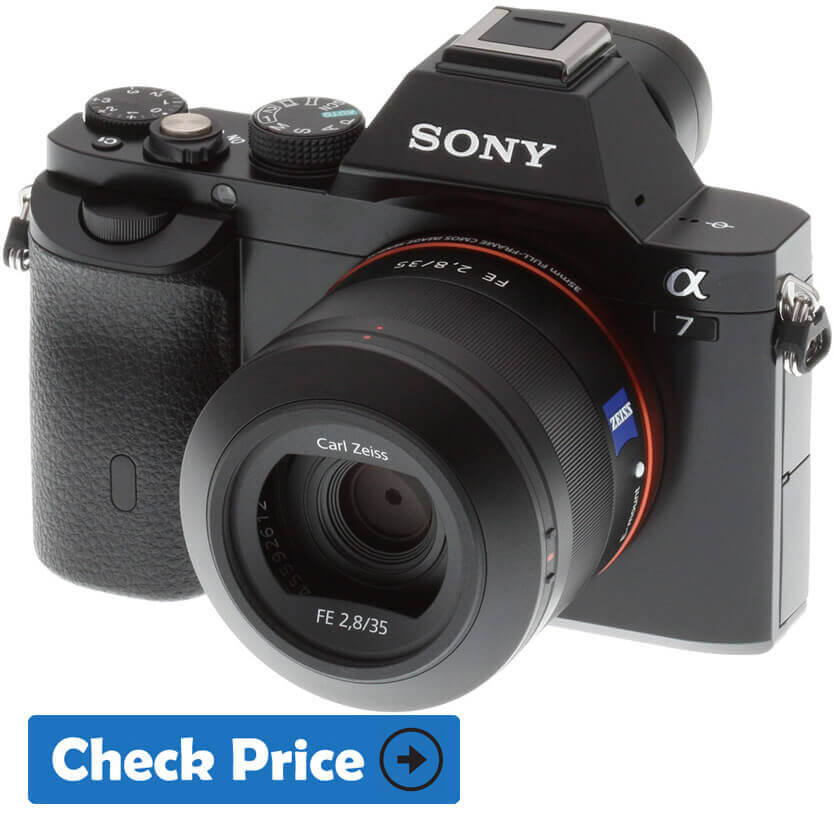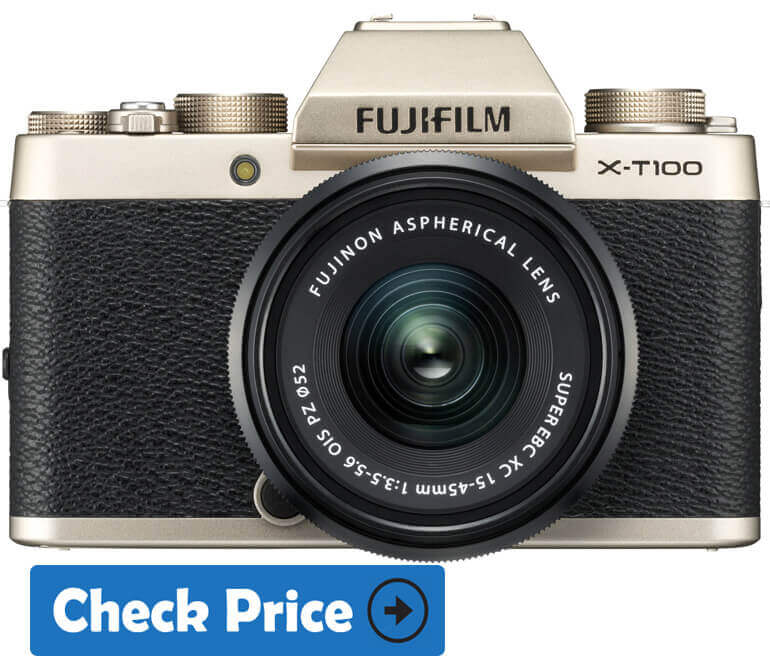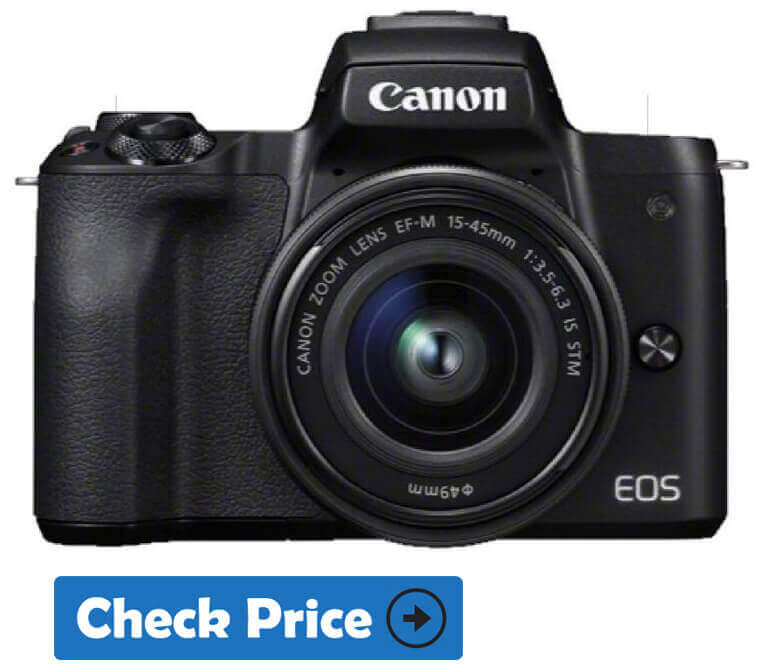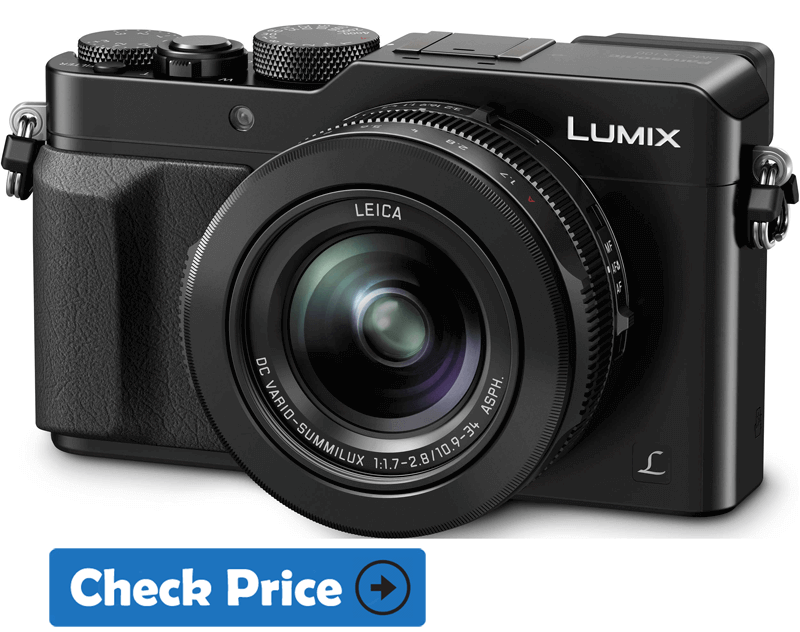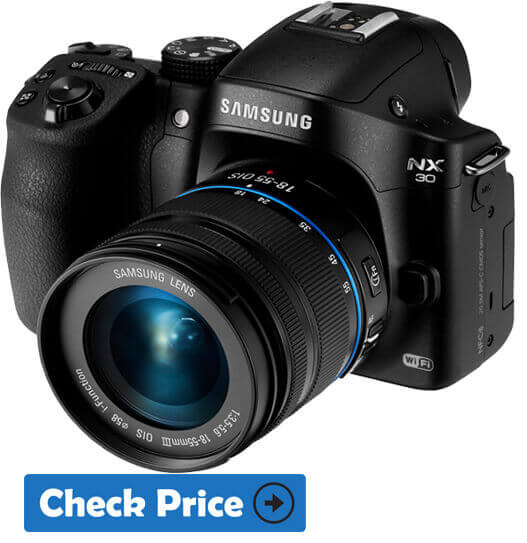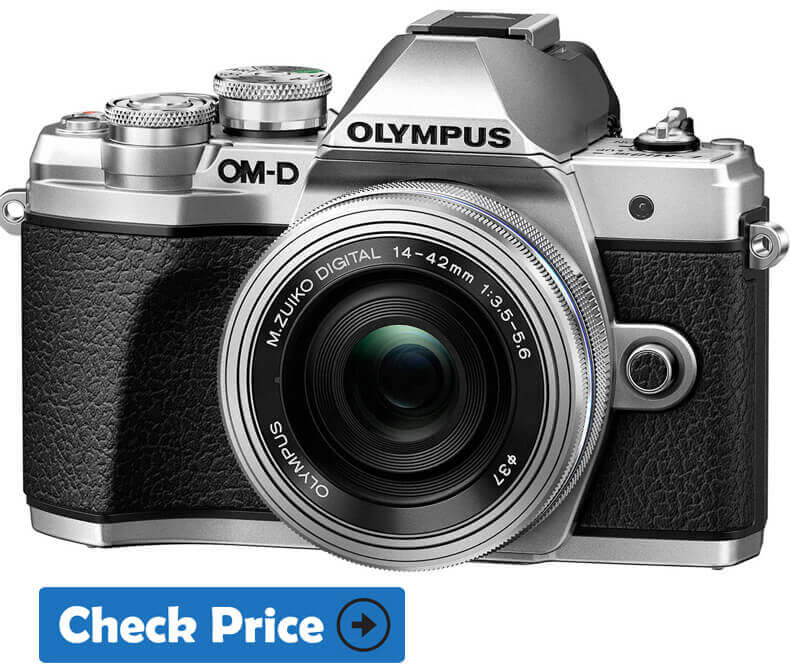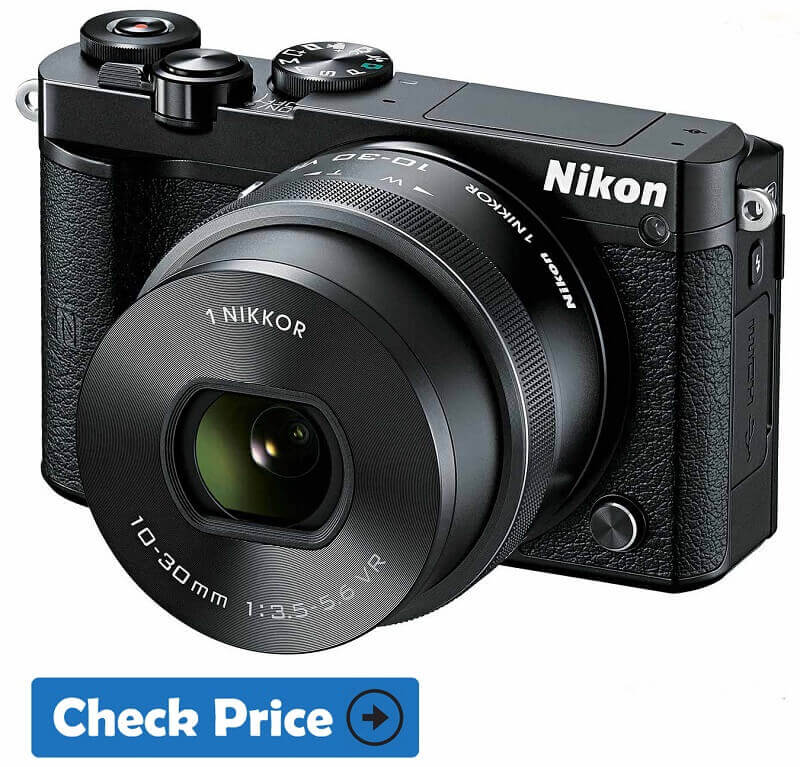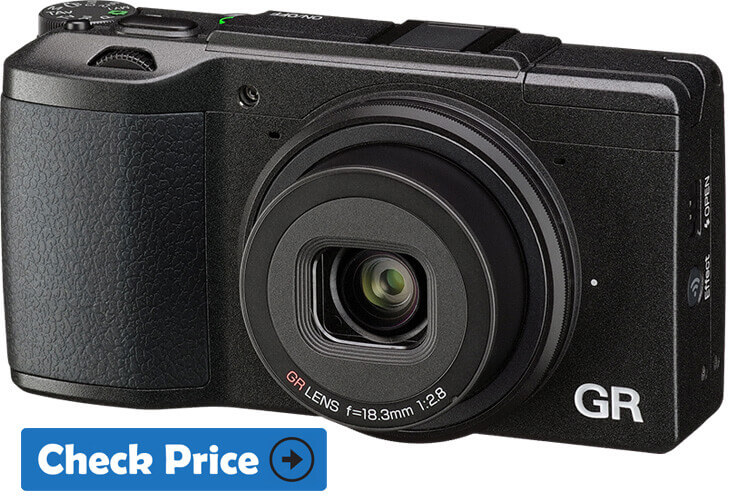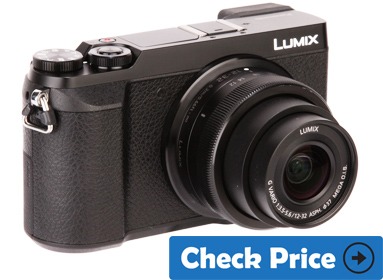Have you decided to switch from your smartphone or compact camera to something more “serious” to take photographs, but the excessive weight of Reflexes scares you?
Would you like a camera with an interchangeable lens that is light, handy and easily transportable anywhere? The answer to your problems is one: you need a mirrorless camera.
in this guide, I will explain to you how to pick Best Mirrorless Camera Under 1000 USD. My Ultimate Buyer’s Guide explains everything to you.
What is Mirrorless Camera
Table of Contents
The mirrorless cameras are compact cameras with interchangeable lenses that offer the user a shooting customization capability similar to that of the Reflex cameras, if not identical. Although a few years ago they were inferior in quality to cameras for professionals, for some years they have combined the reduced dimensions to picture quality and video recording at the highest levels.
Also Read: Best Vlogging Camera under 500
However, choosing a mirrorless is not a child’s task, because you need to know the basics of photography, the basics of making a perfect shot and the fundamental components that make up a camera. But don’t be afraid:
This article will explain to you step by step how to choose the model made to measure for you among the best mirrorless on the market.
Let’s begin!
Why are Mirrorless Cameras Better?
Is a mirrorless camera better than a digital SLR?
- The optical part of the Mirrorless camera is in strong development, and even if it is still a little less provided than that of the reflex, one begins to find interesting focal lengths, with particular fixed focal lengths pancakes light, light and discrete. Some brands even share their mount, such as Olympus and Panasonic for the micro 4/3 with very compact optics or Panasonic, Leica and Sigma via the “L-MOUNT ALLIANCE” for the format 24 x 36 mm. Finally, with adapters, you can mount almost all lenses for SLR on this mirrorless.
- With their dual AF system, which combines the phase correlation (fast and useful for mobile subjects) with contrast detection (accurate but often slow), some mirrorless cameras have very responsive autofocus, sometimes-even more effective than that of SLRs in professional mirrorless cases.
- The electronic viewfinder (EVF) mirrorless are also progressing, with improvements in terms of magnification (perceived size in the viewfinder) and dynamics. Although this viewfinder is not comparable for many photographers to optical viewing, being able to enjoy a preview of the final image (as it will be recorded) allows you to take a serene shot, especially in low light conditions where the electronic viewfinders are very bright compared to the optical system.
The mirrorless viewfinders are also developing optical coupling covered and electronically at Fujifilm and Canon for example. Because of their technical constraints, they are still little exploited but could really tip the balance in the future years. - The video mode implemented on mirrorless has also progressed a lot in recent years thanks to the absence of a mirror. More and more mirrorless cameras are incorporating a 4K / UHD video recording mode, or even 4K Cine, to also appeal to the videomaker target and make the mirrorless a two-in-one package. Coupled with a stabilization of the sensor and those of certain objectives, it is today a real marketing argument.
Best Mirrorless Camera Under 1000 USD of 2024
Best Mirrorless Camera Under 1000$ | Comparison Table
Top Quality | Great Price | 5- Star Picks
| Camera Name | Resolution | Sensor MegaPixel | Price $$ |
|---|---|---|---|
| Sony Alpha A7 (Editor's Choice) | HD 1080p | 24 MP | |
| Fujifilm X-T100 | 4K UHD 2160p | 24 MP | |
| Canon EOS M50 | 4K UHD 2160p | 24 MP | |
| Panasonic Lumix DMC-GX9 | 4K UHD 2160p | 20 MP | |
| Samsung NX30 | FHD 1080p | 20 MP | |
| Olympus OM-D E-M10 III | 4K | 16 MP | |
| Nikon 1 J5 | 4K UHD 2160p | 24 MP | |
| RicohGR II | FHD 1080p | 16 MP | |
| PANASONIC LUMIX GX85 Cheap Mirrosless | 4K UHD 2160p | 16 MP |
Best Mirrorless Camera Under 1000 Dollar | 2024 Products Overview
1. Sony Alpha A7 Mirrorless Camera Under 1000 (Editor’s Choice)
- Sensor Size: Full Frame
- Resolution Max: 1080p
- MegaPixel: 24 MP
- Image Stabilizer: Yes
- Screen 3″, Tilt, Touch
- Connectivity: Wi-Fi
- ISO Range: 100-25600
- Battery Life:
About:
Sony A7 III is a beast with many facets. You can go out and photograph landscapes one day and shoot sports the next day in a beautiful video clip.
This camera has everything you could expect: a high resolution of 42.4-megapixel, rapid shooting speeds, a 4k video with excellent quality. It’s fun to compare the first-generation A7 S with the A7R III. The latest camera is much more refined, but its size has not increased much.
Also Read: Best Action Camera Under 100
- There are manual controls and ports for all around its case. You have a forward and reverse dial for speed and aperture, and an exposure compensation dial, programmable buttons, and three pre-programmed shooting modes. Above the dial of the numeric keypad is the new joystick and on the left the articulated touch screen, which can be tilted up or down but not forward or sideways.
- It’s crazy to take 10 images of 42.4 megapixels per second in a short burst. I would not say that the A7R III is a sports camera, but you could certainly use it for fast-moving action scenes. The large sensor makes it ideal for landscapes and wildlife and you will not disturb athletes, bears or brides during a ceremony using the silent electronic shutter mode.
- Autofocus is faster and more accurate than ever, thanks to a sharp increase in the number of contrast detection points from 25 to 425. The quality of still images in raw mode has improved thanks to the increased range. dynamic and resolution in 14-bit color. This is particularly useful for high ISO shooting.
- Regarding the video field, the A7R III is the best full-frame mirrorless camera you can buy. However, it does not have the same 10-bit colorimetric width of the Panasonic GH5, but it does provide a complete reading of the sensor. And by using the entire sensor, it produces a rendering that the GH5 cannot match.
- Integrated five-axis stabilization and extra weight help a great deal in maintaining stability when shooting freehand.
- The Sony camera is not free of flaws though. The menu system is better than before, but it is still too big and some parameters have been grouped in categories that do not logically correspond to my sense.
- A7 cameras have always been the lightest and most compact full-size cameras on the market. But Sony has made the A7R III a little bigger so that it can accommodate some of the functions we needed the most. It now has a larger battery like that of the A9 with a range of two times greater.
- The app to connect your smartphone to the A7R III is still very tedious, but it does the job.
- There are two SD card slots, one for two high-speed UHF cards, and a USB Type C port, you get a joystick and a touch screen for focusing.
- It has headphone, HDMI and microphone inputs, making it a professional video device that most consumer cameras.
Also Read: Best Lavalier Microphones
- Bigger and brighter electronic viewfinder
- Bright autofocus system
- None
2. Fujifilm X-T100 Best Budget Mirrorless Camera under 1000 USD
- Sensor Size: APS-C
- Resolution Max: 4K
- MegaPixel: 24 MP
- Image Stabilizer: Yes
- Screen 3″, Tilt, Touch
- Connectivity: Wi-Fi
- ISO Range: 200-12800
- Battery Life:
About:
Another interesting mirrorless camera among the cheapest is the Fujifilm X-A10 , which (in extension).
The Fujifilm X-T100 is a beautiful object to take with you everywhere, a real travel companion for everyday images, no frills, but especially the excellent value for money compared to what proposes the competition.
- With a compact body, sophisticated design, good build quality and photographic combined, there is no doubt: it is a pure blood Fujifilm.
- It is robust, well assembled and really beautiful with its retro charm.
- The horizontal covering strip, which separates the two metal elements at the top and bottom, is the only element that betrays the entry-level nature because it looks good but is made of a plastic that is more rigid than that of the higher models.
- I appreciate its low weight and generous support for the thumb on the back.
- It is still quite comfortable to use.
- Compact and lightweight, this box features a cropless 4K 30p mode enhanced hybrid autofocus, with 2.16 megapixels with phase detection for fast, accurate tracking performance.
- The camera also has a new mode of detection of the eye and faces to facilitate the portrait picture.
- It has a 24 MP APS-C CMOS sensor and is combined in this kit with a 16-50mm all-around lens very bright with OIS II function integrated.
- The 3 ″ LCD screen can also be oriented for selfies
- As far as the burst is concerned, up to 6 photographs per second can be taken.
- Supports videos in Full HD at 30 fps, while for autofocus we have up to 49 exploitable points.
- The ISO range is from 100 to 25,600
- It includes a microUSB connection and charging port, the micro HDMI video output and the microphone input. The last is isolated in a compartment on the left, while the other two are on the right.
- both Wi-Fi and Bluetooth LE support, convenient for speeding up the pairing operation with the smartphone and keeping it active.
- The remote control app is not the best in terms of solidity and features.
- Better ISO gain and superior image quality
- incorporates a standard CMOS APS-C sensor with a definition of 24.2 million pixels
- Excellent build quality
- Visible sight fringing
- EV dial easy to hit
- Not found any negative point in it
3. Canon EOS M50 All Purpose Mirrorless Camera Less Than 1000 Dollars
- Sensor Size: APS-C
- Resolution Max: 4K
- MegaPixel: 24 MP
- Image Stabilizer: Yes
- Screen 2″, Tilt, Touch
- Connectivity: Wi-Fi
- ISO Range: 100-25600
- Battery Life:
About:
Competitors have strategically decided to focus on technological development and research for the production and creation of high-performance mirrorless cameras. They have therefore chosen a different market segment than Canon and Nikon. From this, it is clear that overtaking was immediate.
Now Canon with its new mirrorless Canon EOS M50 is trying to reduce this gap compared to other mirrorless on the market.
The Canon EOS M50 is another excellent mirrorless, very cheap but with excellent shutter qualities, especially if you're just starting out with the world of photography.
- Canon EOS M50 is very stylish and ergonomics design and look like a DSLR cameras.
- The designers have maintained a design that is practically the same for the rings and for the various reliefs on the body in aluminum mixed with polycarbonate (more the opposite in reality) and then considerably increase the grip.
- The left side almost completely empty, the central part occupied by the hotshoe slide and a right side invaded by a ring that surrounds the shutter button, the program dial, a button function, the on / off switch, and the video recording key.
- The front is rather minimal and shows in a clear view the shutter button (which we highlighted earlier with regards to the upper side), the Canon logo, the central hotshoe slide, the focusing light, the attachment for the optics and the quick release button for lenses.
- This model implements a 24.2 MP APS-C CMOS sensor with automatic and manual modes.
- It has a burst of 10fps in AF-S mode or up to 7.4fps in AF-C, which is a good value for this price, and you can also take advantage of smartphone-style touch-screen controls.
- A DIGIC 8 processor derived directly from more professional models, autofocus with Dual Pixel system (which is a good Canon exclusive)
- Its video recording in 4K @ 24fps
- Let’s not forget the 99-point AF (Auto-Focus) which, coupled with the Dual Pixel system, can really behave very well.
- Its ISO performance is superb when you compare it with the other models of the same price.
- It has an adjustable 3″ touch screen LCD monitor
- The tracking of moving subjects has also been improved compared to other models. And ” eye detection ” has been added.
- The LP-E12 lithium battery can last on average 235 shots or 85 minutes of footage.
- It can connect to external devices via Bluetooth and WiFi and with the Canon Connect app
- the immediate sharing of photos and videos (of your “stories”) directly on smartphones, or on social media really becomes child’s play.
- Canon also provides the Irista Cloud service, to back up your photos and videos via Wi-Fi and Bluetooth
- Tracking of faces and subjects by automatic recognition
- Perfectly balanced body
- Excellent image sensor
- Dual pixel autofocus
- Integrated flash
4. Panasonic Lumix DMC-GX9 Best for 4k Mirrorless Video Cam Under 1000$
- Sensor Size: Four Thirds
- Resolution Max: 4K
- MegaPixel: 24 MP
- Image Stabilizer: Yes
- Screen 3″, Tilt, Touch
- Connectivity: Wi-Fi
- ISO Range: 200-25600
- Battery Life:
About:
The Panasonic Lumix DMC-GX9 is a great mirrorless with Micro Four Thirds sensor, capable of taking good quality 16 MP photos.
The GX9 is a surprisingly fast mirrorless. Turn on, image processing, image display, menu scrolling, touch function, AF. Everything works smoothly and with great efficiency, which makes it a really nice camera to use.
- It boasts a good general build quality, with a simple but functional rectangular shape.
- It can use any lens designed for the four-thirds microsystem, with a wide range of options from Panasonic, Olympus and a third-party series, which therefore makes it a very versatile machine.
- The viewfinder, flash, and slide are located inside a flat top plate, while the front is well structured and offers an excellent solid grip in hand.
- It offers several manual controls and quick access to different settings, a combination that could pleasantly surprise even experienced photographers who love the manual.
- It has a Dual IS image stabilizer but it is mainly characterized by the possibility of recording video at 4K resolution.
- It costs very little and implements a 24-Megapixel Micro Four Thirds sensor, combined with a 12-32 mm lens in the base kit. Excellent to start both on the photographic and video filming sectors.
- The Integrated on the camera body is a 2.76 million dot LCD viewfinder, while the traditional display has touch-screen functionality and can be tilted, this feature considered very valuable by different photographers.
- It supports for 4K videos in the AVCHD format Progressive, vintage and elegant aesthetics are the strengths of the Panasonic Lumix DMC-GX9
- It has a new focus mode lever, in which you can choose between manual focus, single AF or continuous AF, and since it is proposed as a street camera, quick access to mass control in focus is a very important element.
- The battery life is just 260 shots and 250 shots with the EVF (adding some videos, you can easily go down to 200).
- It is equipped with WiFi and Bluetooth, which consumes less energy than Wi-Fi and allows us to remotely control and share images using a smartphone via the Panasonic image app.
- It also equipped with Micro USB and Mini HDMI ports, although unfortunately, it lost the microphone input we had on the GX8.
- 49-point contrast-sensing autofocus system
- Extremely compact dimensions
- small body and at an attractive price
- Integrated stabilization for sharper results
- Integrated flash
- Silent shutter
- Non-tropicalized body
- Uncomfortable default settings for use with viewfinder
5. Samsung NX30 Best for Artful Focusing
- Sensor Size: APS-C
- Resolution Max: FHD 1080p
- MegaPixel: 20 MP
- Image Stabilizer: Yes
- Screen 3″, Tilt, Touch
- Connectivity: Wi-Fi
- ISO Range: 100-25600
- Battery Life:
About:
A GREAT mirrorless in the body of a small reflex. The Samsung NX 30 is a border camera. The point of union between two worlds.
Korean engineers have tried to concentrate both the reflex and mirrorless worlds in a single machine.
The intention is to satisfy users accustomed to using an SLR but who want a lighter and less cumbersome machine (but at the same time very comfortable to grip with medium-sized fingers) both users coming from the world of mobile phones and compact phones who want to make the leap in quality towards sensors and lenses of a completely different level, without giving up the ease and speed of shooting and complete connectivity but sacrificing the pocket size.
- The more traditional design of the NX30 means that it can bring together the best of SLR and CSC technology.
- This is undoubtedly our preferred CSC for ergonomics. The handle and the palm rest are superbly shaped for a perfect fit, even in large hands.
- It’s also more comfortable than other mirrorless cameras.
- There is a good distance between the compartment door and the tripod wire, so it may still be possible to remove a card while the camera is mounted on a tripod.
- The electronic viewfinder (EVF) extends to ensure a distance of 36 mm from the back of the camera. It also tilts upwards, which is useful when shooting from a low camera position.
- There is a sensor at eye level to detect when EVF is used, but it is a bit slow to respond when switching between LCD and EVF. When the EVF was not extended and we quickly raised the camera to eye level, we were able to move the autofocus point with a tip to the nose on the touchscreen. The EVF image is very sharp with a resolution of 1.024×768, but unfortunately, it is a bit smaller than the EVF on competing CSCs.
- Samsung’s new flagship comes with leading-edge technical features: 20.3-megapixel CMOS APS-C, phase/contrast hybrid focus, 2.36 million pixels mobile electronic viewfinder
- It has 3-inch Super Amoled adjustable screen
- The shutter speed up to 1/8000
- full HD video, flash, external microphone socket and full Wi-Fi Ncd connectivity. The powder and rain resistant metal body then complete the first-rate endowment from a high-end machine. A complete Adobe Photoshop Lightroom 5 installation disk and license is also supplied.
- The camera operates with sensitivities between 100 and 25600 ISO and offers a recording of Full HD 1080p movies.
- There are two optics with which it is presented: the Samsung 16-50 mm F2-2.8 S ED OIS zoom is noted for the brightness throughout the arc of the covered focal lengths, while the motorized lens with the same Samsung 16-50 focal length mm F3.5-5.6 Power Zoom ED OIS focuses on very small dimensions.
- There is the integration of Wi-Fi and NFC technologies, which are used to provide users with advanced sharing features.
- With the Photo Beam function, it is possible to transfer an image from the camera directly to a tablet or smartphone simply by combining the two devices and without needing any preliminary configuration. MobileLink instead allows you to share multiple images simultaneously with up to four devices.
- With AutoShare, the photos are instead shared the moment they are taken while Remote Viewfinder Pro remotely controls the camera via smartphone.
- It also has a 3.5mm mic input so you can connect external microphone as well.
- lighter design than the SLRs
- 80 ° adjustable electronic viewfinder (XGA resolution, 2,359K-dot)
- 9fps shutter speed
- two 16-50mm lenses
- Not Found
6. Olympus OM-D E-M10 III Best Entry Level Mirrorless Camera Under $1000
- Sensor Size: Micro Four Thirds
- Resolution Max: 4K
- MegaPixel: 16 MP
- Image Stabilizer: Yes
- Screen 3″, Tilt, Touch
- Connectivity: Wi-Fi
- ISO Range: 200-25600
- Battery Life:
About:
It is actually a camera that has only the price of entry level since the performances are those of a top of the range.
And in fact, I loved her so much (and not just because she is beautiful!).
We then have the Olympus E-M10 Mark II, a mirrorless with a classic design that uses a five-axis stabilization system to take photos without blur.
Before jumping into its features, I tell you it is not suitable in my opinion for those who want vlogging because it doesn't have microphone input.
Lets move to its specifications;
- I really liked this Olympus camera, first of all because of its beautiful appearance, its double color and its vintage look that makes it even more appealing.
- It have a 16 MP Micro Four Thirds sensor, combined with a 14-42mm lens
- It has 5-axis optical stabilization which allows shooting on the move even when walking without the need for other stabilization devices.
- The electronic viewfinder integrated into the body is a quality OLED, while there is the possibility of recording time-lapse video in 4K and slow motion.
- It has two M.Zuiko lenses: a 14-42 mm for closer shots, and a 40-150mm for shots from higher distances.
- supports a range of ISOs from 200 to 25,600.
- It supports a 4.8 fps burst and features a 121-point focusing system, and can record video at 4K Ultra HD resolution at 60 frames per second.
- Burst shooting up to 9 frames per second with RAW bursts up to 22 frames
- The display is adjustable and touch-screen.
- The possibility of managing via smartphone via OI.Share software and Wi-Fi connectivity
Also Read: Cheap Vlogging Camera with Flip Screen
- Quick focus & Digital zoom
- Lock rings for room management
- Compact and handy even thanks to the ergonomic groove
- Color detail and file balancing
- Lack of audio jack for the microphone
- Lack of NFC for immediate photo sharing
7. Nikon 1 J5 Mirrorless Camera Under $1000
- Sensor Size: 1″
- Resolution Max: 4K UHD 2160p
- MegaPixel: 24 MP
- Image Stabilizer: Yes
- Screen 3″, Tilt, Touch
- Connectivity: Wi-Fi, NFC
- ISO Range: 100-25600
- Battery Life:
About:
The Nikon 1 J5 , one of the most successful models of the Nikon chain regarding mirrorless.
It really gave a hard time to reflexes.
It more lightweight and professional mirrorless camera, and have become the ideal photographic machines for the amateur photographer who wants to have fun with professional instruments.
It stimulates creativity already at the first impact, its adjustable display is closely linked to the possibility of taking pictures with unlikely shots, ideal for shots different from the usual.
Also Read: Cheap Camera for Youtube
- The incredible lightness is the aspect that most strikes us when we take it in hand.
- Weighing just 265 grams, The Nikon 1 J5 is one of the lightest mirrors ever.
- The design is decidedly refined, with a style in the balance between modern and vintage, especially if we choose the white color (alternatively we can have it black or gray ).
- The construction materials are of the highest quality, as is the ergonomics on which Nikon has worked very well. Worthy of note is the closing of the lens characterized by a technologically interesting solution: instead of the classic lens cap, the final part is retracted and covers the lenses, similar to the compact mechanism.
- It uses a 24 MP Full-Frame CMOS sensor with 273 focus points and a high quality 3.7 MP OLED viewfinder.
- This model also features a 3 ″ LCD Touch and supports video recording at 4K Ultra HD at 30 fps.
- It can shoot 400fps video for slow-motion mode, with a lower resolution and an ultra-widescreen 2.67: 1 ratio. Despite the different resolution, the quality is adequate for uploading movies on any Social Network or Youtube platform, Vimeo and the like.
- The same screen is at the cutting edge being a touch screen and gives the possibility to enlarge the shots just taken to check the quality in real-time.
- Smart Photo Selector allows the camera to capture 20 photos with a single press on the shutter, analyze individual images and leave only the best photos for clarity and brightness.
- The processor used is the Expeed 6, while as regards the native ISO range we have from 100 to 25600.
- It saves files in JPG format already suitable and compatible for both the web and for printing, but at the same time, it has the possibility of being able to shoot in RAW.
- From ISO 100 to 800, the Nikon mirrorless keeps very well without the slightest perception of noise, from 1600 to 3200 you begin to perceive a slight presence that increases in sensitivity becoming more and more present.
- This mirrorless has a hybrid autofocus system with 105 sensing focus points and 171 contrast focusing points.
- With Wi-Fi your Nikon will be connected in real time to your smartphone
- Also support micro HDMI and USB
- Adjustable Touch Screen for creative shots
- Super-fast in shooting
- Flash also usable for bounce
- Zoom with incorporated cap
- Slightly noisy zoom
- Absence of a slide for external flashes
- Electronic and non-optical image stabilization
Its weight and size underline how this is the strength of this mirrorless.
8. RicohGR II Mirrorless Camera Under 1000
- Sensor Size: Full Frame
- Resolution Max: FHD 1080p
- MegaPixel: 16 MP
- Image Stabilizer: Yes
- Screen 3″, Tilt
- Connectivity: Wi-Fi NFC
- ISO Range: 100-25600
- Battery Life:
About:
The Ricoh GR II is probably the best compact camera available on the market today. we has put it to the test with fully satisfactory results for those looking for high quality in an extremely pocket-sized product.
Inside the package, we find the classic equipment of compact cameras, which is a rechargeable battery with its battery charger, the cd-rom with the software to be installed on the pc, the wrist strap, and the user manual.
- The first impression one has of this camera is that it is really very small: with it’s 111.7 mm x 61 mm x 34.7 mm it is, in fact, possible to hold it comfortably in the palm of a hand.
- It has a very compact body in magnesium alloy, with a design practically identical to the model that directly preceded it, namely Ricoh GR: the lines are essential and not retro like most cameras on the market today. The flash is integrated and positioned in the upper left part of the body, the slots for the battery and for the SD card are in the lower part, while the USB and HDMI sockets are to the right of the camera body, closed by a flap.
- Most of the controls are located on the back next to the LCD screen.
- It is built predominantly in magnesium alloy, even if the plastic is not missing.
- The handle is covered with a layer of knurled rubber material to facilitate finger grip. Despite the very low weight of around 215 grams without battery, the tactile sensation is positive: the Ricoh GR II looks like an absolutely resistant and solid camera, built with remarkable accuracy.
- For high-end compact cameras, the Ricoh GR II stands out for its very small size compared to direct competitors and performance. It is equipped with a 16-megapixel APS-C sensor and a fixed lens with an equivalent focal length of 28 mm and a maximum aperture of f 2.8.
- It can also record video in full HD at 30/25/24 fps in H.264 format. Let’s look at it in detail, starting our review with the contents of the package.
- One of the strengths of this camera is no doubt the 3-inch LCD screen with 1.23 million points, one of the best in the world of mirrorless cameras.
- It uses the same technology that Sony has used on its flagship products, such as the Sony RX100, and that makes the images very bright and bright.
- It is also equipped with an automatic brightness adjustment function that adapts it to the ambient light, to make it always readable.
- In the shooting phase, it shows the information relating to the aperture and shutter speed, the grid to aid in the composition, and the electronic level to indicate the vertical or horizontal inclination of the camera.
- This camera is powered by a lithium battery whose charge level is shown by an icon on the display. Full battery recharging takes about 3 hours while the autonomy of use indicated by the manufacturer is 320 photos. Obviously, by adopting some tricks it can extend its duration, for example by setting the automatic shutdown after a few minutes of inactivity, or by selecting the darkening of the monitor or eliminating sound signals altogether.
- With wi-fi and NFC connectivity, it is possible to quickly transfer files to a PC or watch them directly on a mobile device. It has a very short startup time which makes it a particularly appreciated camera for the street genre.
- The possibility of connecting Ricoh GR II via wi-fi to a PC or mobile device allows quick access to the GR Remote web application, through which the user can remotely control, or from a smartphone, tablet or computer, all the keys and the camera dials.
- In this way, it is possible to better see the macro shots or to take original selfies by checking the composition of the photo even during shooting.
- By installing the Image Sync app on an iOS or Android mobile device, you can quickly transfer files or simply preview them on a larger monitor.
- Excellent image quality
- Good video quality
- Very quick to turn on and shoot
- Very solid construction materials
- Excellent battery life
- Great LCD Display
- Possibility to use manual & customize controls
- It is not equipped with an electronic viewfinder
9. PANASONIC LUMIX GX85 Cheap Mirrorless Camera
- Sensor Size: Micro Four Thirds
- Resolution Max: 4K UHD 2160p
- MegaPixel: 16 MP
- Image Stabilizer: Yes
- Screen 3″, Tilt, Touch
- Connectivity: WiFi, Usb
- ISO Range: 100-25600
- Battery Life:
About:
- The dimensions of this camera is extremely limited, making it quite easy to grip, especially for those with not particularly large hands.
- It has a minimal and compact design, weighing about 380 grams. The presence of the rubberized grip makes it even more functional and pleasant to handle, making it stable and firm during use.
- The Panasonic gx80 is also equipped with a nice feature, which will allow you to get panning fluids with HD resolution from a static video shot in 4k, from applause !!
- The screen is a traditional 3 “LCD with 1 million points. It offers very good visibility, with automatic brightness adjustment and excellent color rendering.
- The 4: 3 image format is wider at the sides of the classic 3: 2 with an optical sensor resolution of 16 megapixels while the size of the optical sensor is 4/3.
- The stabilization on the sensor is composed of 5 axes and in addition, the stabilized lens allows you to take freehand photos up to a second, obviously with a bit of practice and confidence with the machine.
- The sensor of the Panasonic Lumix DMC GX80 is composed of an electronic and mechanical shutter of the latest generation.
- The minimum focal length is 24 mm. The display size is 3 inches with a touch LCD monitor that contains most of the GX80 camera’s features, very simple to use.
- The battery is lithium with 10025 Amph, packed with all the equipment, being present the energy saving function, it is more than sufficient for entry level use.
- Like all the latest generation cameras, the WIFI system is available for best use.
- From the web, it is possible to download the dedicated application on your mobile phone so as to quickly connect the Panasonic DCM-GX80 in a fast and stable manner.
- Perfect 4k video with 25-30 fps
- HD that can reach up to 60 fps
- Timelapse
- built-in flash
With its innovative photographic functions, it is particularly suitable for Street photography and with its ridiculous weight and ergonomics it is ideal for landscape photography.
How to Choose The Best Mirrorless Camera Under 1000 Dollars | Buyer’s Guide
If you are interested to read my thorough & research based camera buying guide, this guide will help you a lot to know each & every thing about the cameras & its technical terms..
Sensor Sizes
The first feature you need to choose when buying a mirrorless is the sensor, which is also the most important component. It is a chip formed by photodiodes that have the task of recording the light and all the information related to it.
In combination with an image processor ( ISP ), the sensor transforms the information into files, which must be saved in a memory card almost always external and in SD format (to be purchased separately). There are mainly three types of sensors, in addition to other models that use smaller sensors - and lower quality - with a diagonal of about 1 ".
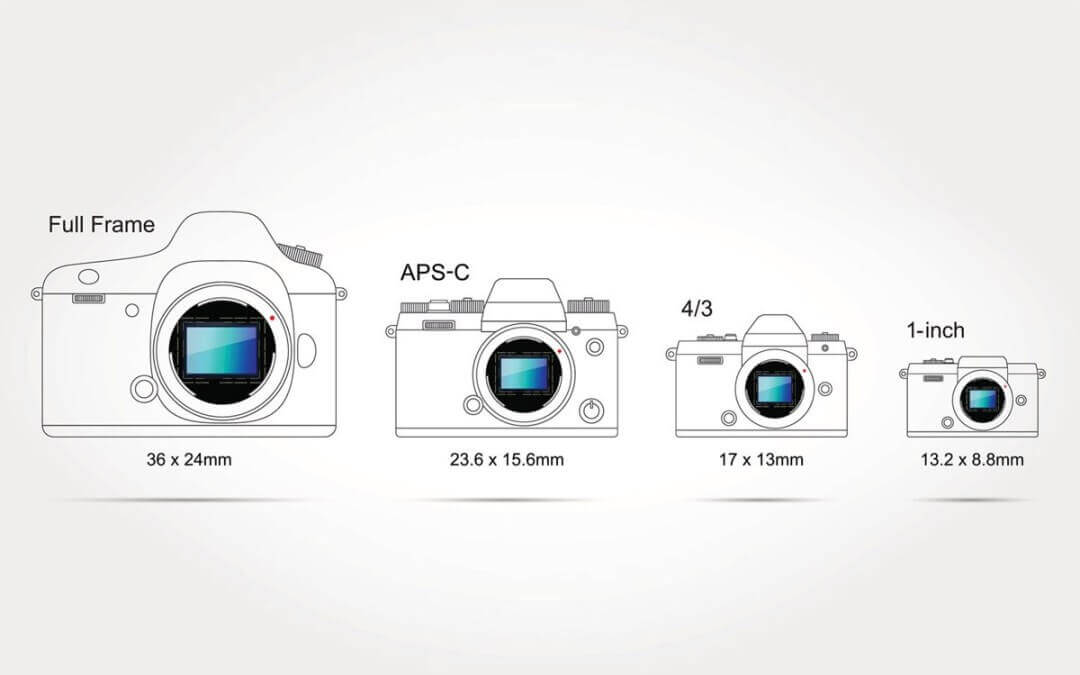
Mirrorless Full Frame
The full-frame mirrorless models are the most expensive and those that offer an absolute higher-quality shot. A full-frame sensor measures 24 × 36 millimeters and is equivalent to the standard 35 mm film format. The full format, as it is called in Italian, is characterized by its ability to capture a greater number of light than other types of sensors. I'll explain why right away.
A full-frame sensor is larger, and therefore for the same resolution, it integrates larger pixels that can give greater clarity and less noise in the same circumstances compared to an APS-C or Four Thirds sensor. They can take a higher field of view, and consequently offer a blurred effect against the background of greater impact. This effect is called jargonly bokeh.
Mirrorless APS-C
If the full format is too much for you and you want something qualitatively valid, but at the same time you don't want to faint on the economic level, there are many models of mirrorless APS-C on the market. They are the most widespread and clearly adopt an APS-C sensor measuring 23 × 15 or 22 × 14 millimeters. They carry a crop ratio (cutting factor) of 1.5x on Sony, Nikon, and 1.6x models on Canon models.
If you use a full-frame lens on these cameras (it is possible, but not vice versa), the real focal length will be the one declared multiplied by the crop ratio. The acronym APS-C means Advanced Photo System Type-C (Classic) and identifies a format with an aspect ratio (ratio between the long side and short side) of 3: 2. Between the two formats that I have indicated to you, there is also the APS-H (High Definition), but it is very little used and you will hardly find a model that uses it.
Mirrorless Four Thirds
Finally, let's point out the Four Thirds mirrorless, or rather those that integrate a Four Thirds sensor. This format measures 17 x 13 millimeters and has a crop ratio of 2x compared to the Full Frame. There are not very many cameras with this type of sensor, and in fact, unless you need a camera that reduces the bokeh I suggest you go directly to the APS-C format, which is also the one preferred by users a little more advanced.
The name Four Thirds does not derive from the aspect ratio, as it is mistaken to think, but the dimensions of the diagonal similar to those of the old cathode ray tube, therefore 4/3 ″.
Resolution MegaPixel
More photodiodes have a sensor and the higher the resolution supported by the photographs. One often thinks - wrongly - that the higher the resolution, the better the quality of the shot. It is measured in megapixels and represents only and exclusively the definition of photography in ideal conditions. The resolving power of a camera (and therefore the ability to capture the finest details) is instead determined by a long series of factors: sensor, response to ISOs, quality of lens elements, and light conditions in the environment.
![]()
You will agree, therefore, with me if I say that Megapixels do not say much, and already a 16 MP model can offer you such a definition to guarantee prints of 30 × 40 centimeters with exceptional quality. Do not dwell too much on this data: now all the mirrorless on the market offer an optimal resolution for the images imprinted on the files.
Video Recording
A mirrorless can not only take pictures but also record videos, with professional quality as well. There are models that are even designed to record video thanks to sensors with not too high resolution. By combining this with interchangeable lenses, you can achieve a high degree of creativity and exceptional shooting quality. If you are interested in video recording, you should mainly consider these basic aspects.
Resolution:
there are various formats that indicate the maximum resolution supported. The HD format indicates a resolution of 1280 × 720 pixels, the Full HD a resolution of 1920 × 1080 pixels, the Quad HD 2K a resolution of 2560 × 1440 pixels, the 4K Ultra HD a resolution of 3840 × 2160 pixels. The latest generation models support at least Full HD, but also consider whether to take a model that records in 4K if you are interested in this particular area and want to be ready for the future.
Bit-Rate
If you want high-quality video check the maximum bit rate supported by the camera. Some models use codecs that compress the image a lot, degrading the image, while others can also support bitrates of 50Mbps and more. The SD memory card must also support this speed. To learn more about this, don't miss my guide on the best SD.
Frame Rate
videos can be recorded normally at 25 or 30 fps ( frames per second ) but if you want a more fluid representation especially of the most animated scenes I suggest you consider video recording at 60 fps. Some models can go further, reaching 120 or 240 fps for playback in slow-motion or slow-motion.
Lenses
Focal length - is the distance between the surface of the sensor and the center of the objective lens when set to infinity. It is expressed in millimeters and establishes the type of objective: normal, when it is equal to the diagonal of the format; wide-angle when it is less than 35mm; telephoto lens, when it is over 50 millimeters; macro when they have a small minimum focusing distance.
Viewfinder
Auto-Focusing
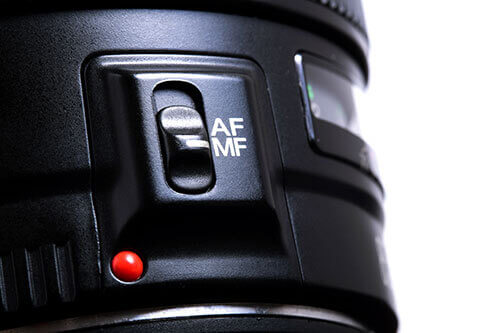 To define the importance of a subject or an element of the photo, the photographers use the "blurred". The most modern mirrorless - such as smartphones, compact cameras, and Reflex cameras - can set a focus point or decide automatically so as to blur everything that is closer and farther away. Jargon is called auto-focus and autofocus, the device can even automatically choose what to emphasize.
To define the importance of a subject or an element of the photo, the photographers use the "blurred". The most modern mirrorless - such as smartphones, compact cameras, and Reflex cameras - can set a focus point or decide automatically so as to blur everything that is closer and farther away. Jargon is called auto-focus and autofocus, the device can even automatically choose what to emphasize.
The mirrorless can have more or less points of focus inserted within a precise space of the sensor. Usually, the sensor surface is covered and the focus is more precise.
Particularly important in this sense is also the speed of focus, which in the last models has now become swift allowing to keep the "focus" constant on an element even if it is in motion. Indispensable for sports photography, and for photos of animals or children.
Image Stabilization
some lenses use a stabilization system to reduce movement during shooting and vibration. The best models allow you to earn up to 4 stops avoiding the micro-blur. Stabilization is essential when there is little light in the environment.
Shutter Or Burst Speed
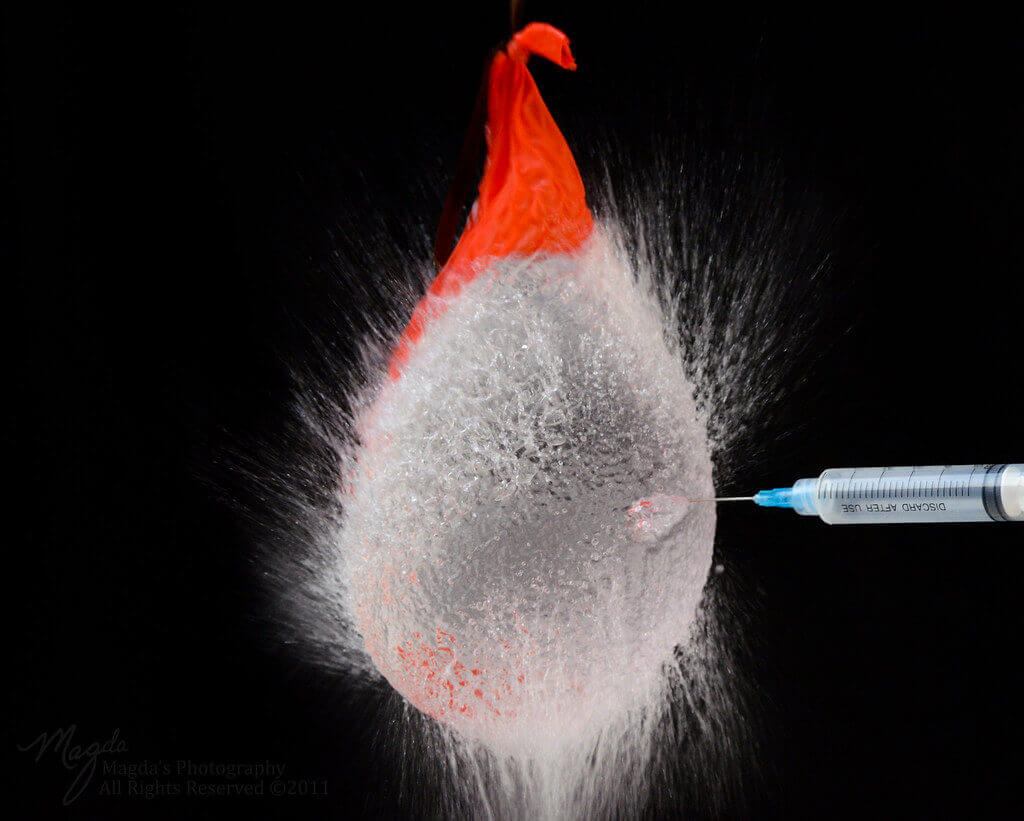 The shutter speed is also fundamental in these last three areas. Experts call it to burst and indicate a series of photos taken and saved quickly in succession by holding down the shutter button.
The shutter speed is also fundamental in these last three areas. Experts call it to burst and indicate a series of photos taken and saved quickly in succession by holding down the shutter button.
The faster the burst, the greater the possibility of obtaining a quality photograph in the circumstances I have specified before (and in all those where you are not sure of the final result).
This is an aspect in which the mirrorless has now surpassed the Reflexes, and some models that are not too expensive allow you to shoot without too many problems even more than 10 frames at full resolution in just one second!
Settings
Battery and Flash
Environmental Sealing
Mirrorless can be tropicalized, which is the term used to define resistance to weathering, to the unwanted introduction of liquids, dust or even shocks. If they are not "standard" and you want to use them in difficult conditions you will have to provide you with special cases for your model, which typically have a very high cost.
ISO Range
We talked about ISO sensitivity and I'll tell you right away what it is. Once, when the film was still used, there were several rollers that supported a higher or lower sensitivity. Now there is no need to change anything on the mirrorless, but it is the sensor that can increase or decrease the sensitivity to acquire or reduce the light captured by the environment. Everything, however, has a cost.
Increasing the ISO sensitivity not only increases the "brightness", but also the noise. A quality sensor reduces the quality degradation, but at high ISO usually the level of detail and the sharpness of the colors are slightly compromised on all the cameras. If you want to find out how a specific model behaves by increasing the value I suggest you consult the many reviews you find online, including those of the excellent DPreview.
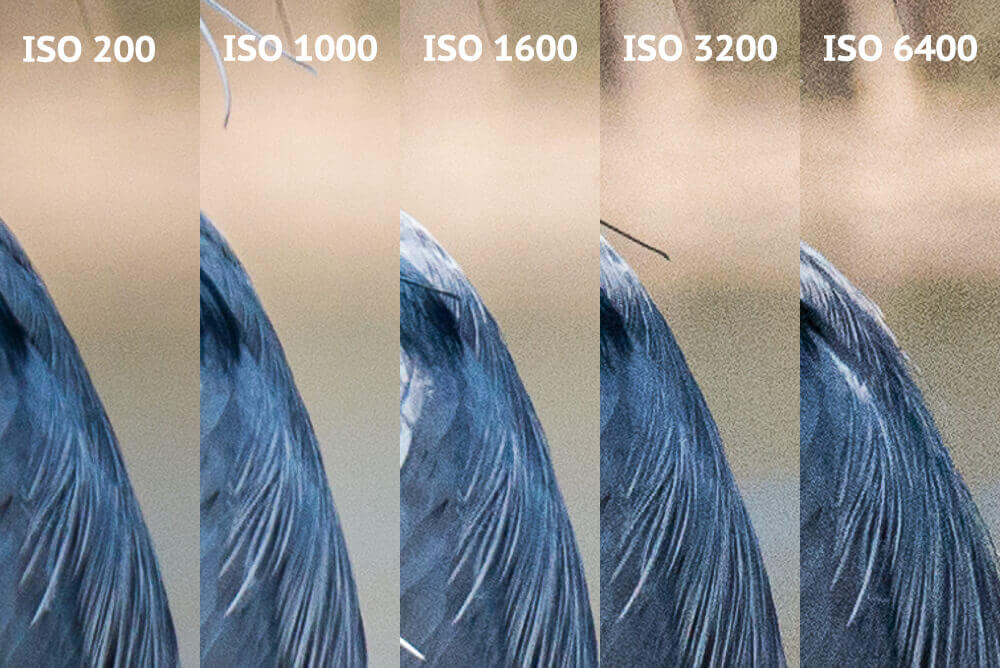
Connectivity
Very important, on a mirrorless, also the connectivity: in addition to the possibility of saving the files on an external SD card, the mirrorless can also transfer them - not always, however - even via cable or via Wi-Fi or Bluetooth. Some models support the NFC for fast pairing with smartphones and tablets, while the more advanced ones also have a GP S module to save information on the shooting position.
Weight
FAQs | Mirrorless Cameras under $1000
What Is The Best Mirrorless Camera To Buy Under $1000?
There are several excellent mirrorless cameras available under $1000 that offer great value for their price. Here are some options to consider:
- Sony Alpha a6000: This camera has been a popular choice for years, offering a 24.3-megapixel APS-C sensor, fast autofocus, 11 frames per second continuous shooting, and a compact design. It's a great option for both stills and videos.
- Fujifilm X-T30: This camera is a great choice for photographers who prioritize image quality and aesthetics. It features a 26.1-megapixel APS-C sensor, Fujifilm's signature film simulation modes, fast autofocus, and 4K video.
- Olympus OM-D E-M10 Mark III: This camera is a compact and lightweight option that doesn't compromise on features. It has a 16-megapixel Micro Four Thirds sensor, in-body image stabilization, fast autofocus, and 4K video.
- Panasonic Lumix G7: This camera offers great value for its price, with a 16-megapixel Micro Four Thirds sensor, fast autofocus, 4K video, and a fully articulating touchscreen. It's a great option for both stills and videos.
- Canon EOS M50: This camera is a versatile option that offers both great image quality and video capabilities. It features a 24.1-megapixel APS-C sensor, fast autofocus, a vari-angle touchscreen, and 4K video.
In summary, there are several great mirrorless cameras available for under $1000, each with its own strengths and weaknesses. It's important to consider your specific needs and preferences when choosing the best option for you.
Which Is the Best Camera Under 1000?
There are several excellent cameras available for under $1000, and the best one for you will depend on your specific needs and preferences. Here are some popular options to consider:
- Sony Alpha a6400: This camera features a 24.2-megapixel APS-C sensor, 11 fps continuous shooting, and 4K video recording. It also has fast autofocus, a tilting touchscreen, and a compact design.
- Canon EOS M6 Mark II: This camera has a 32.5-megapixel APS-C sensor, fast autofocus, 14 fps continuous shooting, and 4K video recording. It also has a tilting touchscreen and a compact design.
- Fujifilm X-T30: This camera features a 26.1-megapixel APS-C sensor, Fujifilm's signature film simulation modes, fast autofocus, and 4K video recording. It also has a tilting touchscreen and a compact design.
- Nikon Z50: This camera has a 20.9-megapixel APS-C sensor, fast autofocus, 11 fps continuous shooting, and 4K video recording. It also has in-body image stabilization, a tilting touchscreen, and a compact design.
- Panasonic Lumix G95: This camera features a 20.3-megapixel Micro Four Thirds sensor, in-body image stabilization, fast autofocus, and 4K video recording. It also has a fully articulating touchscreen and a weather-sealed design.
In summary, there are several excellent cameras available under $1000 that offer great value for their price. When choosing the best camera for you, consider your specific needs in terms of features, image quality, and design.
Which Mirrorless Camera Is Best?
There is no one "best" mirrorless camera as it ultimately depends on your specific needs, preferences, and budget. However, here are some of the top-performing mirrorless cameras currently available:
- Sony Alpha a7R IV: This camera features a 61-megapixel full-frame sensor, fast autofocus, 10 fps continuous shooting, and 4K video recording. It also has a tilting touchscreen and a high-resolution electronic viewfinder.
- Nikon Z7 II: This camera has a 45.7-megapixel full-frame sensor, fast autofocus, 10 fps continuous shooting, and 4K video recording. It also has in-body image stabilization, a tilting touchscreen, and a weather-sealed design.
- Canon EOS R5: This camera features a 45-megapixel full-frame sensor, fast autofocus, 12 fps continuous shooting, and 8K video recording. It also has in-body image stabilization, a fully articulating touchscreen, and a weather-sealed design.
- Fujifilm X-T4: This camera has a 26.1-megapixel APS-C sensor, fast autofocus, 15 fps continuous shooting, and 4K video recording. It also has in-body image stabilization, a fully articulating touchscreen, and a retro design.
- Panasonic Lumix S1R: This camera features a 47.3-megapixel full-frame sensor, fast autofocus, 9 fps continuous shooting, and 4K video recording. It also has in-body image stabilization, a tilting touchscreen, and a weather-sealed design.
In summary, there are several excellent mirrorless cameras available, each with its own strengths and weaknesses. When choosing the best one for you, consider your specific needs in terms of features, image quality, and budget.
Should A Beginner Buy A Mirrorless Camera?
Yes, a mirrorless camera can be a great choice for a beginner photographer. Mirrorless cameras are generally smaller, lighter, and more compact than DSLR cameras, making them easier to handle and carry around. They also typically have fast autofocus, a high frame rate, and advanced features like face detection, which can be helpful for beginners.
In addition, mirrorless cameras offer a variety of benefits such as real-time preview of settings, easier manual focus with focus peaking, and better video capabilities. They are also generally quieter and less obtrusive than DSLRs, which can be an advantage in certain situations.
However, it's important to note that mirrorless cameras can be more expensive than DSLRs, and lenses can also be more costly. It's also worth noting that some beginners may prefer a DSLR camera, as they are generally more familiar and have been around for longer.
Ultimately, the choice between a mirrorless camera and a DSLR camera will depend on your personal preferences, budget, and shooting needs. It's recommended to do research and test out different camera models before making a decision.
Is Mirrorless Faster Than Dslr?
Mirrorless cameras can be faster than DSLRs in some ways, but it ultimately depends on the specific camera model and its features.
One advantage of mirrorless cameras is their fast autofocus system. Since mirrorless cameras use contrast detection or hybrid autofocus, they are typically faster and more accurate in tracking moving subjects than DSLRs. Mirrorless cameras can also have a higher frame rate, allowing you to capture more images per second.
Additionally, since mirrorless cameras do not have a mirror mechanism, they can shoot silently, which can be an advantage when photographing in quiet environments or during events where noise is not desired.
On the other hand, DSLRs typically have larger buffers, allowing them to shoot for longer periods without pausing to transfer images. They also typically have longer battery life than mirrorless cameras.
Overall, while mirrorless cameras may be faster in certain aspects, DSLRs can still offer advantages in terms of battery life, buffer capacity, and overall durability.
Is Mirrorless Easier Than Dslr?
Whether mirrorless cameras are easier than DSLRs ultimately depends on personal preference and experience level. Both types of cameras have their own learning curves and can be challenging to master.
One advantage of mirrorless cameras is their smaller size and lighter weight, making them more compact and easier to carry around. They also tend to have simpler controls and menu systems, which can make them easier to navigate and use for beginners.
However, some users may find the electronic viewfinder (EVF) in mirrorless cameras to be less intuitive than the optical viewfinder in DSLRs. The EVF shows a digital representation of the scene in real-time, whereas the optical viewfinder shows the actual scene. Some photographers prefer the natural look of the optical viewfinder and find it easier to use.
Additionally, some beginners may find that DSLRs are more familiar and easier to learn since they have been around for longer and are more commonly used in photography.
In summary, whether mirrorless cameras are easier than DSLRs depends on the individual's preferences and experience level. It's recommended to try out both types of cameras and see which one feels more intuitive and comfortable to use.
What Are The Best Cameras Around $1,000 In 2024?
There are many excellent cameras available for around $1,000 in 2024. Here are some of the best options:
- Sony Alpha a6400: This mirrorless camera features a 24.2-megapixel APS-C sensor, fast autofocus, 11 fps continuous shooting, and 4K video recording. It also has a tilting touchscreen, built-in Wi-Fi and Bluetooth, and a compact design.
- Canon EOS M50 Mark II: This mirrorless camera has a 24.1-megapixel APS-C sensor, fast autofocus, 10 fps continuous shooting, and 4K video recording. It also has a fully articulating touchscreen, built-in Wi-Fi and Bluetooth, and a lightweight design.
- Fujifilm X-T30: This mirrorless camera features a 26.1-megapixel APS-C sensor, fast autofocus, 8 fps continuous shooting, and 4K video recording. It also has a tilting touchscreen, built-in Wi-Fi and Bluetooth, and a retro design.
- Nikon D5600: This DSLR camera has a 24.2-megapixel APS-C sensor, fast autofocus, 5 fps continuous shooting, and Full HD video recording. It also has a fully articulating touchscreen, built-in Wi-Fi and Bluetooth, and a lightweight design.
- Panasonic Lumix G85: This mirrorless camera features a 16-megapixel Micro Four Thirds sensor, fast autofocus, 9 fps continuous shooting, and 4K video recording. It also has in-body image stabilization, a weather-sealed design, and a fully articulating touchscreen.
These cameras all offer great features and performance for their price, but the best camera for you will ultimately depend on your specific needs and shooting preferences.
Which Camera Is Best For Quality?
There are many cameras that offer excellent image quality, and the best camera for quality will depend on the user's specific needs and budget. Here are some cameras that are known for their high-quality images:
- Sony Alpha 1: This professional-level mirrorless camera features a 50.1-megapixel full-frame sensor, advanced autofocus system, 30 fps continuous shooting, and 8K video recording.
- Canon EOS R5: This full-frame mirrorless camera has a 45-megapixel sensor, fast autofocus, 12 fps continuous shooting, and 8K video recording. It also has in-body image stabilization and a weather-sealed design.
- Nikon Z7 II: This full-frame mirrorless camera features a 45.7-megapixel sensor, an advanced autofocus system, 10 fps continuous shooting, and 4K video recording. It also has dual memory card slots and a rugged, weather-sealed design.
- Fujifilm GFX 100S: This medium format mirrorless camera features a 102-megapixel sensor, advanced autofocus system, 5 fps continuous shooting, and 4K video recording. It also has in-body image stabilization and a compact design.
- Sony Alpha 7R IV: This full-frame mirrorless camera has a 61-megapixel sensor, fast autofocus, 10 fps continuous shooting, and 4K video recording. It also has in-body image stabilization and a high-resolution electronic viewfinder.
These cameras all offer excellent image quality, but they can be quite expensive. However, there are many more affordable options available that still provide excellent image quality, such as the Sony Alpha a7 III, Canon EOS R6, and Nikon Z6 II, among others.
What Is The Highest Camera Quality Ever?
There have been many cameras with very high image quality throughout history, but the current highest resolution camera on the market as of my knowledge cutoff date of September 2021 is the Fujifilm GFX 100S. It features a 102-megapixel medium format sensor that produces incredibly detailed and sharp images.
However, it's worth noting that image quality is not solely determined by resolution, and there are many other factors that contribute to image quality, such as dynamic range, color accuracy, low light performance, and lens quality, among others. Therefore, the "highest camera quality ever" is subjective and can depend on the user's specific needs and preferences.
Is Fujifilm Better Than Sony?
Both Fujifilm and Sony are well-known camera brands that offer high-quality cameras with their own unique features and strengths. It's difficult to say which brand is objectively better than the other because it ultimately depends on the user's specific needs and preferences.
Fujifilm is known for its film simulations, which allow users to replicate the look of classic film stocks in their digital images. Fujifilm also offers a wide range of high-quality lenses that are specifically designed for their cameras, and many Fujifilm cameras have a retro design that appeals to users who value aesthetics.
Sony, on the other hand, is known for its advanced autofocus system, fast continuous shooting, and high-quality video capabilities. Sony also offers a wide range of full-frame mirrorless cameras, which are popular among professional photographers and videographers.
Both Fujifilm and Sony offer high-quality cameras with excellent image quality, so it ultimately comes down to the user's specific needs and preferences when choosing between them.
Do Professionals Use Mirrorless?
Yes, many professional photographers and videographers use mirrorless cameras. Mirrorless cameras have become increasingly popular in recent years due to their compact size, fast autofocus system, and high-quality image and video capabilities. Mirrorless cameras also offer the advantage of an electronic viewfinder, which allows users to see exactly what the final image will look like before they take the shot.
Many professional photographers and videographers have switched from traditional DSLRs to mirrorless cameras, including well-known photographers such as Zack Arias, David Hobby, and Colby Brown, among others. Some professional photographers may still prefer DSLRs for specific use cases, but mirrorless cameras have become a popular choice for many professionals.
Do You Prefer Dslr Or Mirrorless?
As an artificial intelligence language model, I do not have personal preferences or emotions as humans do. However, I can provide information and opinions on the differences between DSLR and mirrorless cameras to help users make an informed decisions based on their specific needs and preferences.
Are Mirrorless Cameras Sharper Than Dslr?
Both mirrorless and DSLR cameras can produce sharp and high-quality images, and the sharpness of the final image depends on several factors such as the lens quality, sensor resolution, and image processing algorithms.
However, mirrorless cameras do have certain advantages that can contribute to sharper images. For example, because mirrorless cameras do not have a mirror mechanism, they can use shorter flange focal distances, allowing for lenses to be mounted closer to the sensor. This can result in sharper images with fewer aberrations and distortions. Additionally, mirrorless cameras often use contrast-detect autofocus systems, which are very accurate and can ensure that the image is in focus before the shot is taken.
On the other hand, DSLRs have advantages such as a faster autofocus system, a more durable and rugged design, and longer battery life. However, both types of cameras can produce sharp and high-quality images with the right lens and technique. It's important to choose the camera that fits your specific needs and preferences.
How Do I Choose My First Mirrorless Camera?
Choosing your first mirrorless camera can be a daunting task, but here are some factors to consider that can help you make an informed decision:
- Budget: Determine your budget and look for a camera that fits within it. There are many great mirrorless cameras available at different price points, so you should be able to find a camera that meets your needs and budget.
- Sensor Size: Consider the sensor size you need. Full-frame sensors offer the best image quality but can be more expensive. APS-C sensors are a good compromise between image quality and cost, while Micro Four Thirds sensors are smaller and more affordable.
- Lens Selection: Consider the lens selection for the camera you are interested in. Look for a camera that has a good selection of lenses that fit your needs and budget.
- Image Stabilization: Consider whether the camera has in-body image stabilization (IBIS) or whether you will need to rely on lenses with image stabilization. IBIS can be very useful for shooting in low light or when using longer lenses.
- Autofocus System: Look for a camera with a fast and accurate autofocus system that can handle the types of photography you are interested in.
- Size and Ergonomics: Consider the size and ergonomics of the camera. Mirrorless cameras are generally smaller and lighter than DSLRs, but some people prefer a larger camera with more physical controls.
- Brand and User Interface: Consider the brand and user interface of the camera. Some brands may have a user interface that is more intuitive to you, so it's worth trying out different cameras in person to see which one you prefer.
Ultimately, the best camera for you will depend on your specific needs and preferences, but considering these factors can help you choose a camera that will meet your needs and help you grow as a photographer.
Why Do People Prefer Dslr Over Mirrorless?
While mirrorless cameras have become increasingly popular in recent years, some photographers still prefer DSLRs for a variety of reasons. Here are some factors that may influence someone to prefer a DSLR over a mirrorless camera:
- Optical Viewfinder: DSLRs have an optical viewfinder that provides a clear, real-time view of the scene, whereas mirrorless cameras use an electronic viewfinder (EVF) that may have some lag and can be affected by low light. Some photographers prefer the optical viewfinder for its clarity and responsiveness.
- Battery Life: DSLRs generally have better battery life than mirrorless cameras, which can be important if you plan to shoot for long periods of time without access to a power source.
- Autofocus Performance: DSLRs generally have faster and more reliable autofocus performance, especially in continuous shooting modes.
- Ergonomics: DSLRs tend to be larger and heavier than mirrorless cameras, which can provide a more comfortable grip for some photographers, especially those with larger hands.
- Durability: DSLRs are often built to be more rugged and durable than mirrorless cameras, making them a better choice for outdoor or action photography.
However, it's worth noting that mirrorless cameras have improved significantly in recent years and offer several advantages over DSLRs, including smaller size and weight, more advanced autofocus systems, and better video capabilities. Ultimately, the choice between a DSLR and a mirrorless camera will depend on your specific needs and preferences as a photographer.
Conclusion
I am sure that after reading my advice you no longer have any doubts about what to evaluate when purchasing an advanced digital camera. Below, therefore, I propose you the best mirrorless camera under $1000 on the market in terms of value for money.
